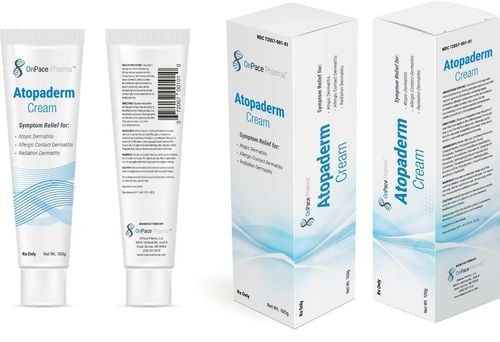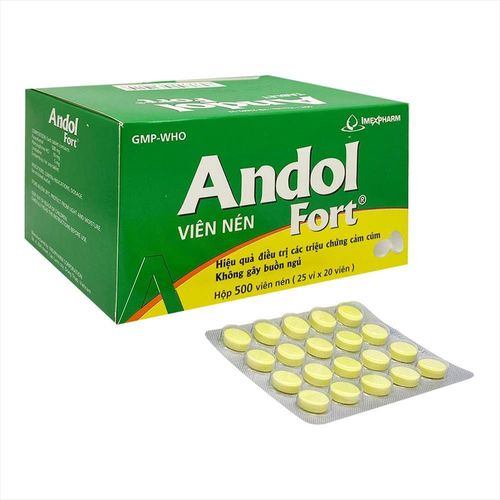This is an automatically translated article.
Dicfiazo gel contains active ingredient Diclofenac sodium 10mg used topically for pain relief and anti-inflammatory effects in joint diseases such as osteoarthritis, periarthritis... Let's learn about the uses and notes when Use the drug Dicfiazo through the article below.
1. Uses of Dicfiazo
Dicfiazo is prepared in the form of a topical gel containing the active ingredient Diclofenac sodium 10mg. Diclofenac belongs to the group of non-steroidal anti-inflammatory drugs (NSAIDs) with antipyretic, analgesic, and anti-inflammatory effects. The drug works by inhibiting the biosynthesis of Prostaglandins - compounds that play an important role in inflammation, pain and fever. Diclofenac has been shown to have a strong analgesic effect in moderate to severe pain. Dicfiazo gel is indicated for topical use to relieve pain and inflammation in osteoarthritis, rheumatoid arthritis, spinal pain, trauma to bones, muscles, joints, ligaments and soft tissue diseases such as inflammation. bursitis , tendinitis...2. Dosage of Dicfiazo
Dicfiazo is used by topical application. The dose of the drug used depends on the condition of the disease, the degree of progression of the disease. Some recommendations on the dose of Dicfiazo are as follows:
Adults: Apply topically 3-4 times a day to help reduce swelling, pain and inflammation, check the effect of Dicfiazo again after 14 - 28 days in case taking drugs to treat bone and joint diseases; Children: There are no recommendations for the use of Dicfiazo in children.
3. Dicfiazo side effects
Dicfiazo may cause some unwanted effects on the skin where the medicine is applied such as rash, contact dermatitis, erythema or reactions at the application site such as itching, inflammation, blistering and pain.Patients need to stop using the drug and notify the treating doctor in case of experiencing side effects when using Dicfiazo.
4. Note when using Dicfiazo
4.1. Contraindications Contraindicated to use Dicfiazo in the following cases:
Patients with hypersensitivity to Benzyl Alcohol, Diclofenac, Sodium Hyaluronate and Macrogol Monomethyl ehter 350; Patients with a history of bronchial asthma, urticaria, allergic rhinitis or allergies when using Acetylsalicylic acid, non-steroidal anti-inflammatory agents. 4.2. Precautions for use Do not let the drug get into eyes and mucous membranes. Diclofenac in particular and non-steroidal anti-inflammatory drugs in general can cause anaphylactoid reactions in patients who have not been previously exposed to Diclofenac. Therefore, caution should be exercised when using Dicfiazo in these subjects. Dicfiazo should be used with caution in patients allergic to Aspirin, in patients with asthma, allergic rhinitis with or without nasal polyps, and severe bronchospasm symptoms after taking NSAIDs. or aspirin. Dicfiazo gel should be used with caution in patients with peptic ulcer disease, gastric bleeding, renal failure, or severe liver failure. Do not use on open wounds, exfoliative dermatitis or other infections.
Systemic side effects when using Diclofenac topical are very small compared to oral administration, because Dicfiazo gel is very poorly absorbed through the body.
Non-steroidal anti-inflammatory drugs (NSAIDs) can affect the function of platelets, although the risk of occurring in the local route is quite low, but caution should be exercised in patients with internal bleeding, endoscopic bleeding.
In case the patient develops a skin hypersensitivity reaction, it is necessary to stop using the drug and notify the treating doctor.
For pregnant women: Do not use Dicfiazo gel in women who are pregnant in the last 3 months of pregnancy, in the remaining stages it is recommended not to use when not really needed. If use is mandatory, the application area should not be too large and the treatment time should not last too long (over 3 weeks). Because the use of prostaglandin inhibitors can lead to adverse effects on the fetus such as damage to fetal kidney function, prolongation of pregnancy, inhibition of uterine contractions, increased risk of bleeding in both mother and fetus, increasing the risk of maternal edema.
For women who are breastfeeding: Dicfiazo gel is not excreted in breast milk, so it can be used in lactating women with appropriate doses.
5. Dicfiazo drug interactions
There are no specific drug interactions when treating Dicfiazo gel with other drugs. However, drug interactions can occur that reduce the therapeutic effect and increase the risk of unwanted effects of Dicfiazo. Therefore, to ensure the safety and effectiveness of treatment, patients need to inform their doctors about the drugs they are using before being treated with Dicfiazo.
The above sharing about Dicfiazo drugs cannot replace the advice of a doctor. Therefore, in addition to understanding the effects of the drug, patients should also use the drug exactly as prescribed by a specialist to achieve the best treatment effect.
Please dial HOTLINE for more information or register for an appointment HERE. Download MyVinmec app to make appointments faster and to manage your bookings easily.













